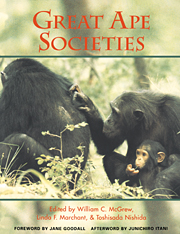Book contents
Foreword: conserving great apes
Published online by Cambridge University Press: 04 August 2010
Summary
The Great Apes, in Africa and Southeast Asia, are endangered. My expertise relates to chimpanzees, and so I will concentrate on them and on forest conservation in Africa. In most cases, the same issues also apply in the conservation of bonobos and gorillas. At the turn of the century, there were hundreds of thousands of chimpanzees living in what are now 25 African nations throughout a more or less unbroken belt of forest from the far west coast of Africa to the eastern shores of Lake Tanganyika. There are still many chimpanzees in the area that was the heartland of their historic range – in the contiguous forests of Cameroon, Central African Republic, Congo, Equatorial Guinea, Gabon and Zaïre. There are still vast areas of forest in some of these countries. But for how much longer? Forests and woodlands worldwide are disappearing as a result of commercial logging and the ever-increasing growth of human populations that tend to compete with and to destroy, rather than to live in harmony with, the natural world. When an area of forest is despoiled, the chimpanzees who live there disappear too: the territorial nature of wild chimpanzees ensures that communities squeezed out by habitat destruction cannot easily integrate with others, away from the devastated areas. Chimpanzees have already become extinct in four of the nations where they once lived and their numbers have shrunk alarmingly in many others.
- Type
- Chapter
- Information
- Great Ape Societies , pp. xv - xxPublisher: Cambridge University PressPrint publication year: 1996



